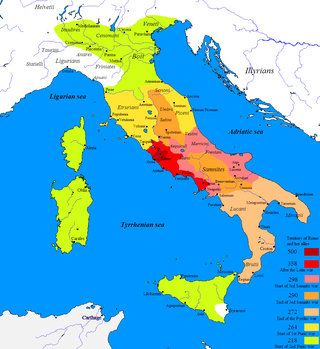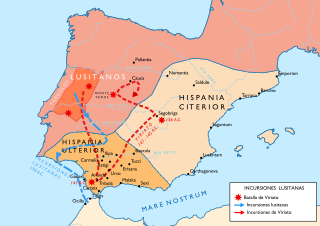This article concerns the period 219 BC – 210 BC.

The First, Second, and Third Samnite Wars were fought between the Roman Republic and the Samnites, who lived on a stretch of the Apennine Mountains south of Rome and north of the Lucanian tribe.
The gens Fulvia, originally Foulvia, was one of the most illustrious plebeian families at ancient Rome. Members of this gens first came to prominence during the middle Republic; the first to attain the consulship was Lucius Fulvius Curvus in 322 BC. From that time, the Fulvii were active in the politics of the Roman state, and gained a reputation for excellent military leaders.

Viriathus was the most important leader of the Lusitanian people that resisted Roman expansion into the regions of western Hispania or western Iberia, where the Roman province of Lusitania would be finally established after the conquest.

The Celtiberians were a group of Celts and Celticized peoples inhabiting an area in the central-northeastern Iberian Peninsula during the final centuries BC. They were explicitly mentioned as being Celts by several classic authors. These tribes spoke the Celtiberian language and wrote it by adapting the Iberian alphabet, in the form of the Celtiberian script. The numerous inscriptions that have been discovered, some of them extensive, have enabled scholars to classify the Celtiberian language as a Celtic language, one of the Hispano-Celtic languages that were spoken in pre-Roman and early Roman Iberia. Archaeologically, many elements link Celtiberians with Celts in Central Europe, but also show large differences with both the Hallstatt culture and La Tène culture.
This is a historical timeline of Portugal.
Quintus Fulvius Flaccus was a plebeian consul of the Roman Republic in 179 BC. Because of his successes in Spain and Liguria, he celebrated two triumphs. Although his political career was a success, he was plagued by controversy and suffered a mental breakdown that culminated in suicide.

The Roman Republic conquered and occupied territories in the Iberian Peninsula that were previously under the control of native Celtic, Iberian, Celtiberian and Aquitanian tribes and the Carthaginian Empire. The Carthaginian territories in the south and east of the peninsula were conquered in 206 BC during the Second Punic War. Control was gradually extended over most of the peninsula without annexations. It was completed after the end of the Roman Republic, by Augustus, the first Roman emperor, who annexed the whole of the peninsula to the Roman Empire in 19 BC.

Marcus Claudius Marcellus was Roman consul for the years 166 BC, for 155 BC, and for 152 BC.

The Numantine War was the last conflict of the Celtiberian Wars fought by the Romans to subdue those people along the Ebro. It was a twenty-year conflict between the Celtiberian tribes of Hispania Citerior and the Roman government. It began in 154 BC as a revolt of the Celtiberians of Numantia on the Douro. The first phase of the war ended in 151, but in 143, war flared up again with a new insurrection in Numantia.
The Second Celtiberian War was one of the three major rebellions by the Celtiberians against the presence of the Romans in Hispania.
The First Celtiberian War and Second Celtiberian War were two of the three major rebellions by the Celtiberians against the presence of the Romans in Hispania.
The First Celtiberian War was the first of three major rebellions by the Celtiberians against the Roman presence in Hispania. The other two were the Second Celtiberian War and the Numantine War. Hispania was the name the Romans gave to the Iberian Peninsula. The peninsula was inhabited by various ethnic groups and numerous tribes. The Celtiberians were a confederation of five tribes, which lived in a large area of east central Hispania, to the west of Hispania Citerior. The eastern part of their territory shared a stretch of the border of this Roman province. The Celtiberian tribes were the Pellendones, the Arevaci, the Lusones, the Titti and the Belli.

The Lusitanian Wars, called Pyrinos Polemos in Greek, were wars of resistance fought by the Lusitanian tribes of Hispania Ulterior against the advancing legions of the Roman Republic from 155 to 139 BC. The Lusitanians revolted in 155 BC, and again in 146 BC and were pacified. In 154 BC, a long war in Hispania Citerior, known as the Numantine War, was begun by the Celtiberians. It lasted until 133 and is an important event in the integration of what would become Portugal into the Roman and Latin-speaking world.
Quintus Fulvius Nobilior was a Roman consul who obtained the consulship in 153 BC. His father Marcus Fulvius Nobilior and his brother Marcus Fulvius Nobilior were also consuls.
This section of the timeline of Hispania concerns Spanish and Portuguese history events from the Carthaginian conquests to before the barbarian invasions.
Punicus was a chieftain of the Lusitanians, a proto-Celtic tribe from western Hispania. He became their first military leader during the Lusitanian War, and also led their first major victories against Rome.

The Conquest of Conistorgis was a military conflict between the Lusitanians and the Roman Republic.








